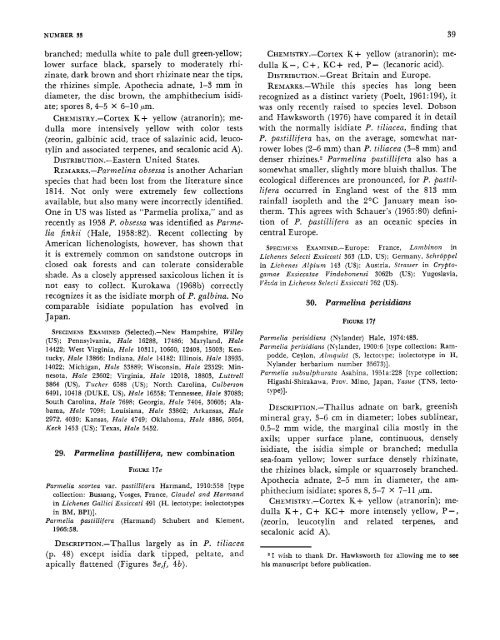A Monograph of the Lichen Genus Parmelina Hale - Smithsonian ...
A Monograph of the Lichen Genus Parmelina Hale - Smithsonian ...
A Monograph of the Lichen Genus Parmelina Hale - Smithsonian ...
You also want an ePaper? Increase the reach of your titles
YUMPU automatically turns print PDFs into web optimized ePapers that Google loves.
NUMBER 88 39<br />
branched; medulla white to pale dull green-yellow;<br />
lower surface black, sparsely to moderately rhi-<br />
zinate, dark brown and short rhizinate near <strong>the</strong> tips,<br />
<strong>the</strong> rhizines simple. Apo<strong>the</strong>cia adnate, 1-3 mm in<br />
diameter, <strong>the</strong> disc brown, <strong>the</strong> amphi<strong>the</strong>cium isidi-<br />
ate; spores 8,4-5 X 6-10 pm.<br />
CHEmsTRY.-Cortex K + yellow (atranorin); me-<br />
dulla more intensively yellow with color tests<br />
(zeorin, galbinic acid, trace <strong>of</strong> salazinic acid, leuco-<br />
tylin and associated terpenes, and secalonic acid A).<br />
DIsTRIsuTI0N.-Eastern United States.<br />
REMARKs.-Parme~ina obsessa is ano<strong>the</strong>r Acharian<br />
species that had been lost from <strong>the</strong> literature since<br />
1814. Not only were extremely few collections<br />
available, but also many were incorrectly identified.<br />
One in US was listed as “Parmelia prolixa,” and as<br />
recently as 1958 P. obses,ra was identified as Parme-<br />
lia finkii (<strong>Hale</strong>, 1958:82). Recent collecting by<br />
American lichenologists, however, has shown that<br />
it is extremely common on sandstone outcrops in<br />
closed oak forests and can tolerate considerable<br />
shade. As a closely appressed saxicolous lichen it is<br />
not easy to collect. Kurokawa (1968b) correctly<br />
recognizes it as <strong>the</strong> isidiate morph <strong>of</strong> P. galbina. No<br />
comparable isidiate population has evolved in<br />
Japan.<br />
SPECIMENS EXAMINED (Selected).-New Hampshire, Willey<br />
(US): Pennsylvania, <strong>Hale</strong> 16288, 17486; Maryland, <strong>Hale</strong><br />
14422; West Virginia, <strong>Hale</strong> 10311, 10660, 12408, 15003; Kentucky,<br />
<strong>Hale</strong> 13866; Indiana, <strong>Hale</strong> 14182; Illinois, <strong>Hale</strong> 13935,<br />
14022; Michigan, <strong>Hale</strong> 33889; Wisconsin, <strong>Hale</strong> 23529: Minnesota,<br />
<strong>Hale</strong> 23602; Virginia, <strong>Hale</strong> 12018, 18803, Luttrell<br />
3864 (US), Tucker 6588 (US); North Carolina, Culberson<br />
6491, 10418 (DUKE, US), <strong>Hale</strong> 16358; Tennessee, <strong>Hale</strong> 37083;<br />
South Carolina, <strong>Hale</strong> 7698; Georgia, <strong>Hale</strong> 7404, 30605; Alabama,<br />
<strong>Hale</strong> 7098; Louisiana, <strong>Hale</strong> 33862; Arkansas, <strong>Hale</strong><br />
2972, 4030; Kansas, <strong>Hale</strong> 4749; Oklahoma, <strong>Hale</strong> 4886, 5054,<br />
Keck 1493 (US); Texas, <strong>Hale</strong> 5452.<br />
29. <strong>Parmelina</strong> pastillifera, new combination<br />
FIGURE 17e<br />
Parmelia scortea var. pastillifera Harmand, 19103558 [type<br />
collection: Bussang, Vosges, France, Claude1 and Harmand<br />
in <strong>Lichen</strong>es Gallici Exsiccati 491 (H, lectotype; isolectotypes<br />
in BM, BPI)].<br />
Parmelia pastillifera (Harmand) Schubert and Klement,<br />
1966:58.<br />
DEscRIPTIoN.-Thallus largely as in P. tiliacea<br />
(p. 48) except isidia dark tipped, peltate, and<br />
apically flattened (Figures 3e,f, 4b).<br />
CHEMISTRY.-cOrteX K + yellow (atranorin); me-<br />
dulla K-, C+, KC+ red, P- (lecanoric acid).<br />
DIsTRrsuTIoN.-Great Britain and Europe.<br />
REMARKS.-while this species has long been<br />
recognized as a distinct variety (Poelt, 1961:194), it<br />
was only recently raised to species level. Dobson<br />
and Hawksworth (1976) have compared it in detail<br />
with <strong>the</strong> normally isidiate P. tiliacea, finding that<br />
P. pastillifera has, on <strong>the</strong> average, somewhat nar-<br />
rower lobes (2-6 mm) than P. tiliacea (3-8 mm) and<br />
denser rhizines.2 <strong>Parmelina</strong> pastillifera also has a<br />
somewhat smaller, slightly more bluish thallus. The<br />
ecological differences are pronounced, for P. pastil-<br />
Zifera occurred in England west <strong>of</strong> <strong>the</strong> 813 mm<br />
rainfall isopleth and <strong>the</strong> 2OC January mean iso-<br />
<strong>the</strong>rm. This agrees with Schauer’s (1965:80) defini-<br />
tion <strong>of</strong> P. pastillifera as an oceanic species in<br />
central Europe.<br />
SPECIMFNS EXAMINED.-EUrOpe: France, Lambinon in<br />
<strong>Lichen</strong>es Selecti Exsiccati 363 (LD, US); Germany, Schroppel<br />
in <strong>Lichen</strong>es Alpium 143 (US); Austria, Strasser in Crypto-<br />
gamae Exsiccatae Vindobonensi 3062b (US); Yugoslavia,<br />
Vtzda in <strong>Lichen</strong>es Selecti Exsiccati 762 (US).<br />
30. <strong>Parmelina</strong> perisidians<br />
FIGURE 17f<br />
Parmelia perisidians (Nylander) <strong>Hale</strong>, 1974:483.<br />
Parmelia perisidians (h’jlander, 1900:6 [type collection: Ram-<br />
podde, Ceylon, Almquist (S, 1ectot)pe; isolectotype in H,<br />
Nylander herbarium number 35673)l.<br />
Parmelia subsulphuuata Asahina, 1951a:228 [t)pe collection;<br />
Higashi-Shirakawa, Prov. Mino, Japan, Yasue (TNS, lecto-<br />
type)l.<br />
DEscRIPTIoN.-Thallus adnate on bark, greenish<br />
mineral gray, 3-6 cm in diameter; lobes sublinear,<br />
0.5-2 mm wide, <strong>the</strong> marginal cilia mostly in <strong>the</strong><br />
axils; upper surface plane, continuous, densely<br />
isidiate, <strong>the</strong> isidia simple or branched; medulla<br />
sea-foam yellow; lower surface densely rhizinate,<br />
<strong>the</strong> rhizines black, simple or squarrosely branched.<br />
Apo<strong>the</strong>cia adnate, 2-5 mm in diameter, <strong>the</strong> am-<br />
phi<strong>the</strong>cium isidiate; spores 8,5-7 X 7-1 1 pm.<br />
CHEMISTRY.-cOrteX K + yellow (a tranorin); me-<br />
dulla K+, C+ KC+ more intensely yellow, P-,<br />
(zeorin, leucotylin and related terpenes, and<br />
secalonic acid A).<br />
*I wish to thank Dr. Hawksworth for allowing me to see<br />
his manuscript before publication.
















